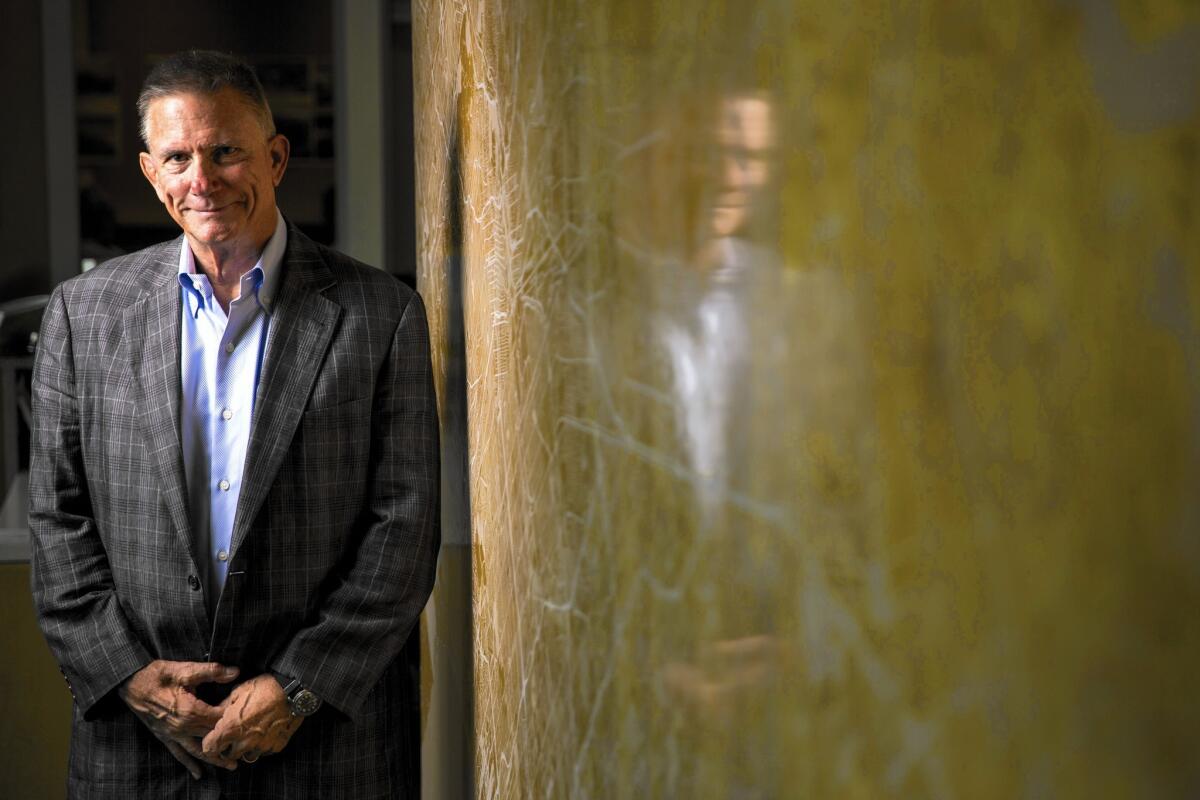How I Made It: Architect breathes new life into L.A.’s historic core

- Share via
The gig: Wade Killefer, who has always liked building things, has become one of the go-to architects for developers who want to convert historic buildings in downtown Los Angeles to new uses such as housing or hotels. Among his most prominent residential conversions are the Art Deco-style Eastern Columbia Building, a former department store on Broadway, and the Pegasus, a former oil company headquarters on Flower Street. But that’s just one specialty for an architect who has also designed single-family homes, libraries, schools and apartment buildings.
Early years: Killefer, 66, grew up in Washington, D.C., and earned a degree in English from Stanford University. Having no particular career in mind upon graduation, he joined a carpenters union to take part in its apprentice program. Soon he decided that his life interests came together in architecture. “Both writing and architecture are about having an idea and then supporting it. They’re just different means of expression,” Killefer said.
Getting launched: Killefer returned to school, securing a graduate degree in architecture at UCLA. There he met his wife and business partner, architect Barbara Flammang. “Barb was a classmate. We were both late to graduate school and had the two worst seats in the studio,” he recalled. Their Santa Monica firm Killefer Flammang Architects just celebrated its 40th anniversary.
Starting small: Many of Killefer’s first jobs involved designing and building houses, and he both drew and literally dug trenches. Soon there was enough demand for his design skills that the architect was able to put down his tool belt and concentrate solely on architecture. He designed a library for a friend and then a private school.
Making a mark: In 1990, the firm completed its first historic renovation, the Mary Andrews Clark Memorial Building on the edge of downtown. The elegant former YWCA residence for young women built in 1913 in the style of a French chateau was converted to housing for low-income single workers. That led to designing conversions of an old office building and the former luxury Town House hotel, both also near downtown, to affordable housing.
Lean years: During the real estate downturn of the 1990s, Killefer concentrated on libraries, schools and other public buildings, including fire stations. His firm became the campus architect for Loyola High School, a Jesuit preparatory school for young men that is one of the oldest schools in Los Angeles. “We’ve had a pretty varied practice,” Killefer said.
Finding a niche: Killefer’s expertise in converting old buildings to new uses made him a likely candidate to join Los Angeles developer Tom Gilmore’s pioneering plan to take advantage of the city’s Adaptive Reuse Ordinance of 1999. Gilmore surprised many real estate industry observers with his financially successful creation of housing, restaurants and shops in rundown former office buildings in downtown’s historic core. Other developers soon followed with similar projects. “Everybody thought Tom would fail,” Killefer said, “and then people said, ‘If that guy can do it, we can do it.’”
Priming the pump: Following that success, Killefer and his team walked the historic core of downtown and in 2001 created a list of buildings that would be suitable for adaptive reuse. Since then, his firm has designed the adaptive reuse of more than 40 downtown buildings. Among the latest downtown are the popular Ace Hotel and the NoMad and Freehand hotels, both under construction in long-vacant office buildings.
Speed bumps: Business for architects ebbs and flows with real estate cycles. When the market goes cold, like it did during the last economic downturn, business dries up. Killefer and his wife didn’t take salaries from their firm during a tough year in the late 2000s. “Recessions are brutal,” he said.
Personal best: Killefer said he is most proud of his contributions toward creating residences for people of modest economic means. His latest is the New Pershing Apartments, a 69-unit complex built by the Skid Row Housing Trust at 5th and Main streets in downtown L.A. Killefer’s design saved the three-story facade of the Charnock Block building erected there in 1889 that later became known as the Pershing Hotel.
Family time: Killefer and Flammang live in Santa Monica, where their firm his based. In his off-hours, he likes to spend time outdoors, hiking and fishing. They have two grown children, a daughter who is doing earthquake relief work in Nepal and a son who is a real estate developer — a suprise career choice to Killefer. “When they were growng up, we took them around to look at buildings and they thought there was nothing more boring than that,” he said.
Design trends: The architect supports dense development, especially housing, in the blocks around transportation hubs such as train stations. Most recent buildings are three to seven stories, but Killefer would prefer taller buildings with open space around them. “I hope the next generation will be taller, thinner buildings,” he said.
Twitter: @rogervincent
More to Read
Inside the business of entertainment
The Wide Shot brings you news, analysis and insights on everything from streaming wars to production — and what it all means for the future.
You may occasionally receive promotional content from the Los Angeles Times.











